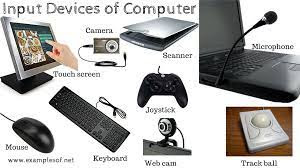How a computer works ?
What is Computer?
Computer is a digital electronic machine which can be programmed to done sequences of arithmetic and Logical operations. A Computer that includes hardware, operating system, and peripherals.
Ancient times computers were used only for calculations . Simple manual instruments like the abacus. Charles Babbage originated the concept of a programmable computer. Considered the father of computer.
Alan Turing who was proposed the principle of the modern computer. Turing developed a device called Universal Computing machine and that is now known as a Universal Turning Machine.
Types Of Computer
- Analog computers.
- Digital computers.
- Hybrid computers.
Classification by size
- Supercomputer.
- Mainframe.
- Server Computer.
- Workstation Computer.
- Personal Computer or PC.
- Microcontroller.
- Smartphone.
- References.
Input Device
A n input device is a equipment used to provide data and control signals to an information processing system.
Examples of input devices are :
- Keyboard
- Mouse
- Scanners
- Cameras
- Joysticks
- Microphones
- Light pen
- Trackball
- Webcam
- Graphic Tablet etc.
Central Processing Unit( CPU )
It is the electronic circuitry, which executes instructions comprising a computer program.
The CPU Performs basic arithmetic, logical, controlling, input and output operations. It processes the data and produces output, which may be stored by an application or displayed on the screen. Most of the CPUs have only one processor. Modern CPU have at least two processor or "processing cores". A CPU with two cores is called a dual-Core CPU. Four cores CPU called quad-Core CPUs. Each processor within CPU typically has its own ALU, FPU, Register, and L1 cache.
The control unit of the central processing unit regulates and integrates the operations of the computer. It selects and retrieves instructions from the main memory in proper sequence and interprets them .
All input data are transferred via the main memory to the arithmetic-logic unit for processing, which involves the four basic arithmetic functions such as addition, subtraction, multiplication, and division and some logic operations such as the comparing of data and the selection of the desired problem-solving procedure or a viable alternative based on predetermined decision criteria.
Type of CPU
- Single-Core CPU: It is the oldest type of CPU which is used in most of the personal and official computers. It can execute only one command at a time and its not good for multi-tasking.
- Dual-Core CPU: It is a single CPU that comprises of two strong cores and functions like dual CPU acting like one. The dual-core CPU manages the multitasking effectively.
- Quad-Core CPU: The quad-core CPU is a elegant model of multiple core CPU features and design with four cores on a single CPU. Similar to dual-core CPU. It is enable for effective multitasking.
- Hexa-Core CPU: It is another multiple core processor which has six cores and can execute the task which works rapidly than the quad-core and dual-core processors.
- Octa-Core CPU: Octa processors are developed with eight independent cores to execute an effective task that is efficient and even acts rapidly than quad-core processors.
- Deca-Core CPU: Deca-core is available with ten independent cores that are deployed to execute and manage the task that is successful than other processors that are developed until now.
Speed Of Computer.
Computer could not work without a CPU. The CPU transfer data near the speed of Light. CPU that utilizes electrical signals 299,792,458 m/s. The speed depends upon medium(material used for transmit electrical signals).
CPU (Central Processing Unit)
-intel
- celeron
- pentium
- pentium MMX
- Core 2 DUO
- Dual Core.
- Quad Core.
- Xeon.
- i3.
- i5.
- i7.
- i9.
- Ryzen 3.
- Ryzen 5.
- Ryzen 7.
- Ryzen 9.
- Ryzen Threadripper with up to 64 cores.
GPU
GPU stands for Graphics Processing Unit. It is a kind of processor designed to regulate graphics rendering. GPUs can process many divisions of data simultaneously.
Memory
Memory is the device used to store instructions and data needed to process raw data and generate output.
There are two types of memory
- Primary memory.
RAM and ROM are primary memory.
RAM stands for Random Access Memory which is a primary volatile memory. Where data is stored as the processor needs it. operating system is located in RAM.
ROM is stands for Read Only Memory. It is a non-Volatile memory. It receives data and permanently writes it on a chip. It lasts even after you turn off the computer. It is used to store the start up instructions for a computer.
2. Secondary memory.
Secondary memory is known as backup memory . It is a no-volatile memory that is not directly accessible by the CPU. In Secondary memory programs and data are kept for a long time. It allows user to store data that may be instantly and easily retrieved. Hard Drive, SSD, Flash, Optical Drive, USB Drive are the example for secondary storage devices.
Output devices
An output device is an computer hardware equipment which converts information into a human readable form. It can be text, graphics, tactile, audio, or video.
example for output devices: monitors, printers, headphones, projectors, GPS devices, Optical mark readers etc.
How does a computer works
- Data is input with the help of input devices.
- Computer that holds data and instructions in the memory for processing.
- The input gets transformed into output in processor. CPU execute instructions and performing arithmetic and logical operations on the input data.
- Output is the final product of data processing. we can receive output from output devices.

















Comments
Post a Comment